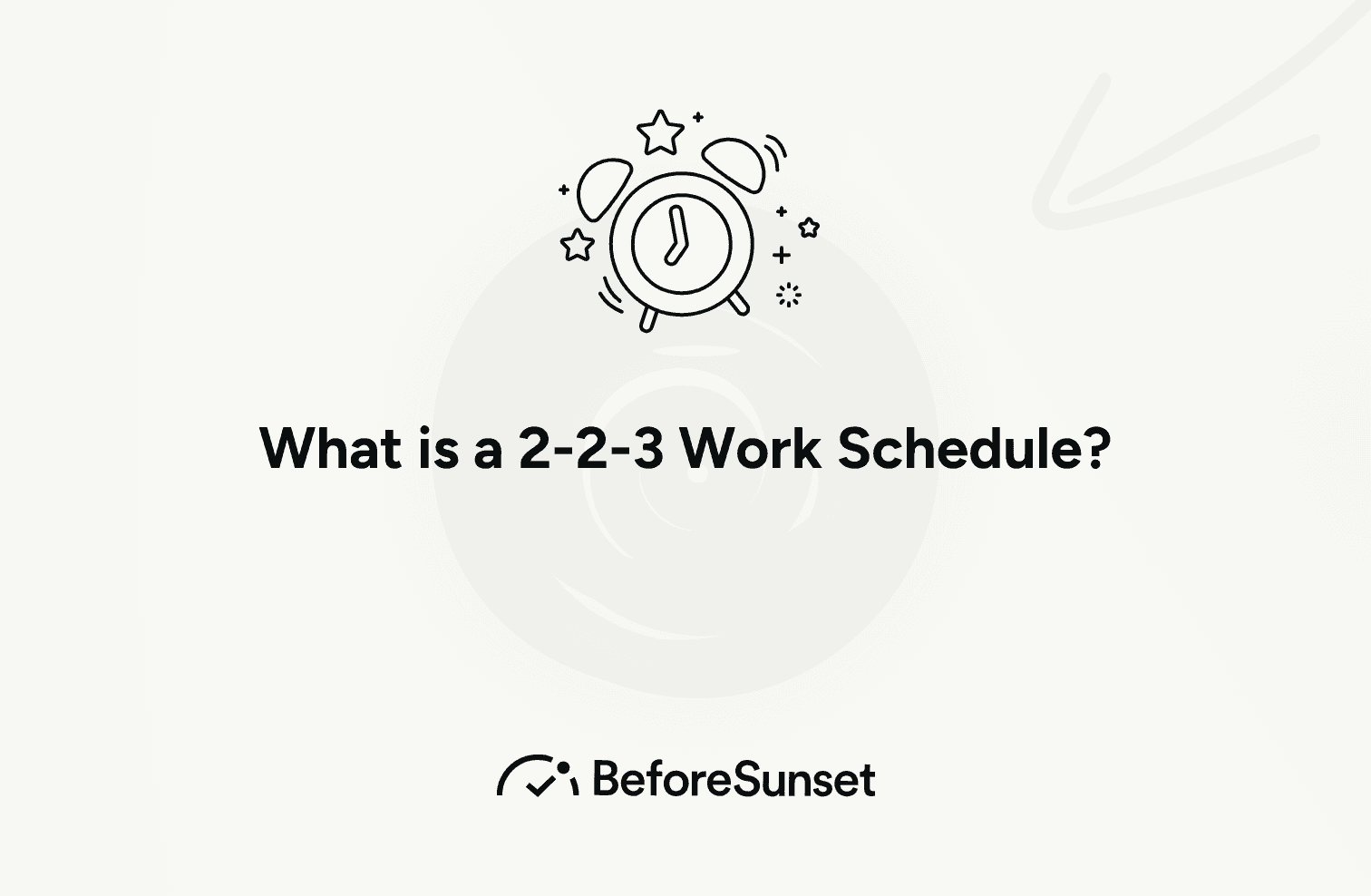In today's fast-paced work environment, businesses are constantly seeking new and innovative ways to improve productivity and employee satisfaction. One such innovation is the 2-2-3 work schedule, a unique shift pattern gaining popularity across various industries. This schedule is particularly common in settings that require continuous operations, such as manufacturing, healthcare, and emergency services.
You might also like:
Understanding the 2-2-3 Work Schedule
The 2-2-3 work schedule, also known as the Panama schedule, is a rotating shift pattern that provides employees with more flexibility and time off compared to traditional work schedules. It operates on a two-week cycle and can be broken down as follows:
Week 1:
Work two days
Off two days
Work three days
Week 2:
Off two days
Work two days
Off three days
This cycle repeats, ensuring that employees work the same number of days each month. Typically, shifts are 12 hours long, which results in employees working 84 hours every two weeks. Over a month, this averages out to 42
hours per week
which is comparable to the standard 40-hour workweek but with extended periods of rest.
Advantages of the 2-2-3 Work Schedule
Increased Productivity
One of the most significant benefits of the 2-2-3 work schedule is its potential to boost productivity. The extended shifts mean that employees spend more consecutive hours focused on their tasks, which can lead to more efficient workflow and less time lost to shift changes. Additionally, the regular and predictable time off allows employees to rest and recharge adequately, reducing burnout and increasing overall productivity when they are at work.
Enhanced Work-Life Balance
Balancing work and personal life is a critical aspect of employee satisfaction and productivity. The 2-2-3 schedule offers substantial periods of time off, allowing employees to better manage their personal commitments, hobbies, and family time. This balance can lead to improved mental health, reduced stress, and higher motivation and productivity during work hours.
Reduced Absenteeism
With more days off and a predictable schedule, employees are less likely to feel the need to take unscheduled leave. This reduction in absenteeism not only helps maintain productivity levels but also ensures that staffing levels are consistent, which is crucial for operations that require a continuous workforce.
Challenges of the 2-2-3 Work Schedule
While the 2-2-3 work schedule offers several benefits, it also presents challenges that both employers and employees need to consider.
Long Shifts
Working 12-hour shifts can be demanding, both physically and mentally. Employees may find it challenging to maintain high levels of focus and productivity for such extended periods. It's essential for employers to provide adequate breaks and create a work environment that supports sustained productivity and well-being.
Adjusting to Rotating Shifts
The rotating nature of the 2-2-3 schedule means that employees need to be adaptable. Switching between day and night shifts can disrupt sleep patterns and potentially affect productivity and health. Effective time management and strategies to adjust sleep schedules are crucial for employees to cope with these changes.
Tips for Maximizing Productivity on a 2-2-3 Work Schedule
Prioritize Sleep: Ensure you get enough rest during off days and adjust your sleep schedule gradually when switching between day and night shifts.
Healthy Lifestyle: Maintain a balanced diet, exercise regularly, and practice stress-reduction techniques to stay energized and focused during long shifts.
Efficient Time Management: Plan your days off effectively to complete personal tasks and recharge. This can help you return to work refreshed and ready to maintain high productivity levels.
Utilize Breaks: Take advantage of scheduled breaks during shifts to rest and avoid fatigue. Short, frequent breaks can help sustain focus and productivity throughout the day.
Stay Hydrated and Nourished: Keep hydrated and eat nutritious meals to sustain energy levels during long shifts. Avoid excessive caffeine and sugary snacks that can lead to energy crashes.
Conclusion
The 2-2-3 work schedule presents a unique approach to managing work shifts, offering numerous benefits such as increased productivity, enhanced work-life balance, and reduced absenteeism. However, the challenges of long shifts and rotating schedules require careful management and strategies to maintain productivity and well-being. By understanding and effectively adapting to this schedule, both employers and employees can reap its benefits and achieve a more efficient and satisfying work environment.
Remote Workers and the 2-2-3 Work Schedule
As remote work becomes increasingly prevalent, the adaptability of various work schedules is being tested. One such schedule is the 2-2-3 work schedule, traditionally used in industries requiring continuous operations. The shift pattern of working 12-hour shifts in a slow rotation cycle—working two days, off two days, then working three days—can be advantageous for remote workers too, despite its origin in more physically demanding environments.
Flexibility and Balance
Flexible schedules are a significant benefit for remote workers. The 2-2-3 work schedule offers extended periods of time off, allowing remote workers to better manage their personal lives. The alternating days on and off provide opportunities to handle household responsibilities, engage in leisure activities, and maintain a social life. This balance is crucial for maintaining overall well-being and improved productivity.
Managing Sleep Cycles and Energy Levels
Working consecutive day shifts and night shifts can be challenging for remote workers, particularly when adapting their sleep cycles. The human brain thrives on routine, so transitioning between day and night work requires careful planning. Incorporating power naps and practicing good sleep hygiene can help maintain consistent energy levels and reduce stress levels.
Health and Well-being
Extended shifts and rotating schedules can lead to potential health issues if not managed properly. Remote workers following the 2-2-3 schedule must be vigilant about maintaining a healthy lifestyle. Regular exercise, a balanced diet, and adequate rest during rest days are essential to prevent burnout and maintain high productivity.
Navigating Labor Laws and Employee Feedback
For remote workers, adhering to labor laws is as important as it is for traditional workers. Employers must ensure that overtime hours are tracked and compensated appropriately, reflecting the hourly rate agreements. Regular employee feedback sessions can help identify any issues arising from the rotational shifts, ensuring that the type of schedule implemented meets both productivity goals and employee well-being.
Applicability to Different Sectors
While the 2-2-3 schedule is commonly used in law enforcement agencies and manufacturing, its principles can be adapted for remote work. Industries that require continuous online support, such as customer service or IT support, can benefit from this rotational shift. This type of schedule ensures that operations continue smoothly without overburdening any single employee.
Conclusion
The 2-2-3 work schedule, with its unique blend of consecutive day shifts and rest days, can be a viable option for remote workers. By leveraging the benefits of flexible schedules and carefully managing sleep cycles and energy levels, remote workers can achieve a balanced social life and enhanced productivity. Employers must consider employee feedback and comply with labor laws to ensure the schedule's success. As remote work evolves, innovative schedules like the 2-2-3 offer promising solutions to modern work-life balance challenges.
Enhancing the 2-2-3 Work Schedule with BeforeSunset AI
The 2-2-3 work schedule offers a unique approach to managing work shifts, with its alternating pattern of 12-hour shifts, providing extended periods of rest and balancing work-life commitments. While this schedule is advantageous in many ways, integrating a productivity tool like BeforeSunset AI can significantly enhance its benefits. By focusing on the human aspect of productivity, BeforeSunset AI empowers individuals to optimize their workdays and become the best planners they can be. Here’s how BeforeSunset AI’s features can complement the 2-2-3 work schedule.
Time-Blocking
With the 2-2-3 work schedule, managing long shifts and ensuring productivity can be challenging. BeforeSunset AI’s time-blocking feature helps by planning your to-do list using the time-block technique. This can be done either with the help of an AI assistant or manually, in sync with your calendar. For those working extended hours, time-blocking ensures that tasks are organized efficiently, allowing you to maintain focus and manage your time effectively.
Time-Tracking
The 2-2-3 work schedule involves a mix of consecutive day shifts and night shifts, which can make it hard to keep track of how much time is spent on each task. BeforeSunset AI’s time-tracking feature allows you to start a timer for each task, providing clear insights into where your time goes. This is particularly useful for identifying patterns in productivity and ensuring that each task receives the appropriate amount of attention.
Analyze Yourself
To thrive in a 2-2-3 work schedule, self-analysis is crucial. The Personal Analytics screen in BeforeSunset AI allows you to view your productivity score and gain insights to become the best planner. Understanding your productivity patterns, especially during long and rotating shifts, helps in making informed adjustments to your schedule and improving overall efficiency.
AI Assistant
BeforeSunset AI’s AI assistant can automatically plan your day, make tasks actionable, and create subtasks. This feature is incredibly beneficial for those on a 2-2-3 work schedule, as it takes the guesswork out of planning and helps you stay organized, regardless of your shift timing. Letting the AI assistant plan your day automagically ensures that you maximize your productivity without getting overwhelmed.
Google and Outlook Sync
Synchronizing your work schedule with your personal life is essential, especially on a 2-2-3 work schedule. BeforeSunset AI offers Google sync and Outlook sync to keep up with your meetings and important events. This eliminates the need to switch between tabs or apps, ensuring that all your commitments are in one place and easily accessible.
Recurring To-Dos
For tasks and events that recur regularly, BeforeSunset AI provides a recurring to-do feature. This is perfect for managing routine tasks in a 2-2-3 work schedule, as you can set to-dos on a daily, weekly, monthly, or yearly basis. This ensures you never miss a recurring task, keeping your work and personal life organized.
Prioritization
With the 2-2-3 work schedule, some tasks may need more immediate attention than others. BeforeSunset AI’s prioritization tags help differentiate tasks based on their urgency. This feature helps the AI create a better schedule tailored to your needs, ensuring that high-priority tasks are addressed promptly.
Invite/Work with Team
Collaboration can be a challenge when working different shifts. BeforeSunset AI’s invite/work with team feature allows you to invite team members to work in sync, fostering better teamwork. This is particularly useful for those on a 2-2-3 work schedule, as it helps maintain communication and collaboration despite varying work hours.
Focus Mode
Long shifts can lead to distractions. BeforeSunset AI’s Focus Mode eliminates distractions, helping you stay on track during your 12-hour shifts. This feature is especially beneficial for maintaining high levels of focus and productivity throughout your shift.
Note Taking and Bookmark
Keeping track of important thoughts and tasks is crucial. BeforeSunset AI’s note taking and bookmark features allow you to jot down notes and easily access your favorite tasks and notes instantly. This ensures that no important information is lost and you can quickly refer to key points as needed.
In conclusion, integrating BeforeSunset AI with a 2-2-3 work schedule can significantly enhance productivity and work-life balance. Its comprehensive suite of features—time-blocking, time-tracking, AI assistant, Google sync, Outlook sync, recurring to-dos, prioritization, invite/work with team, Focus Mode, note taking, and bookmark—ensures that remote workers can manage their schedules effectively, stay productive, and maintain a healthy work-life balance.

